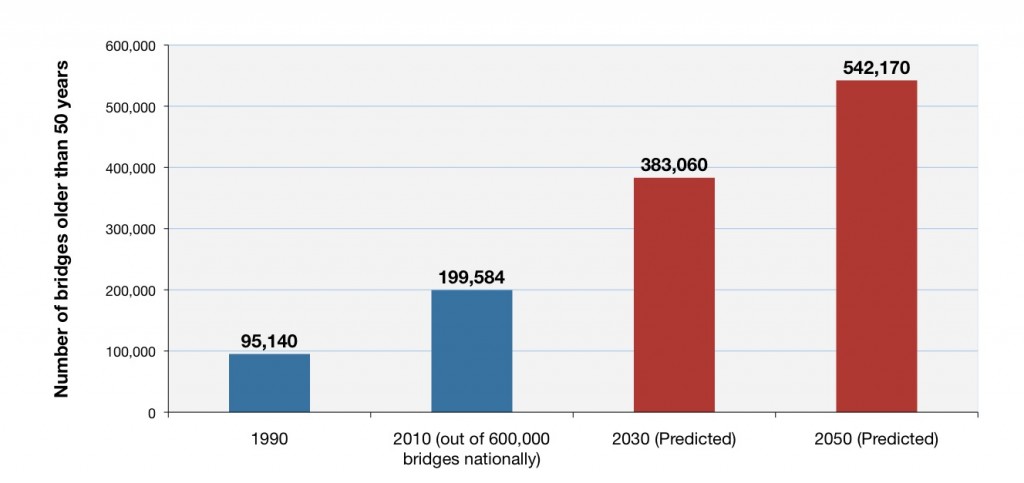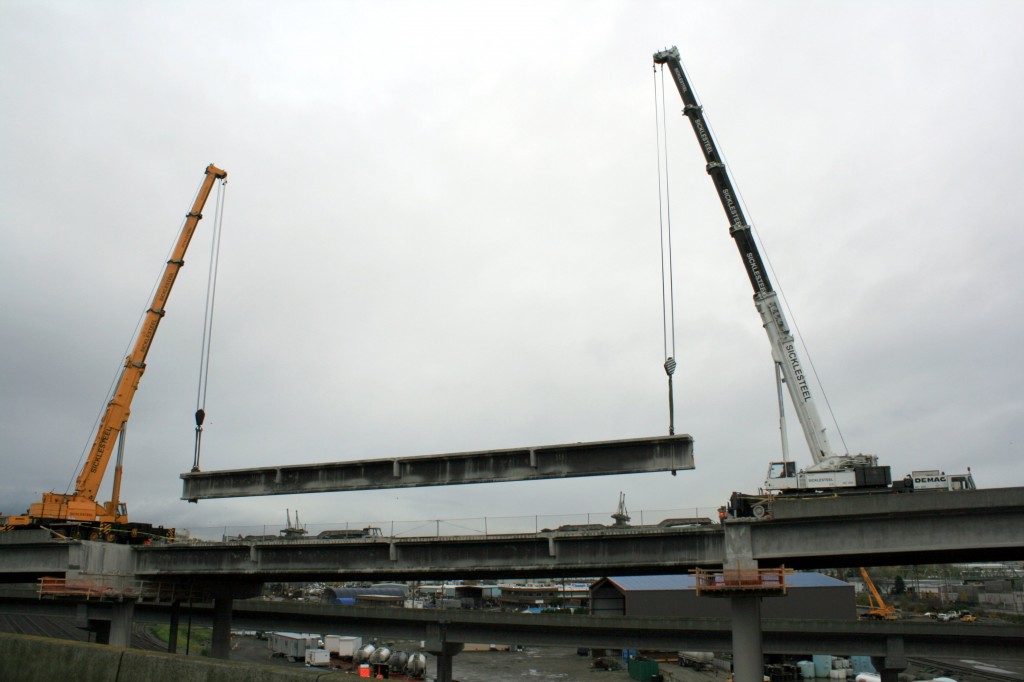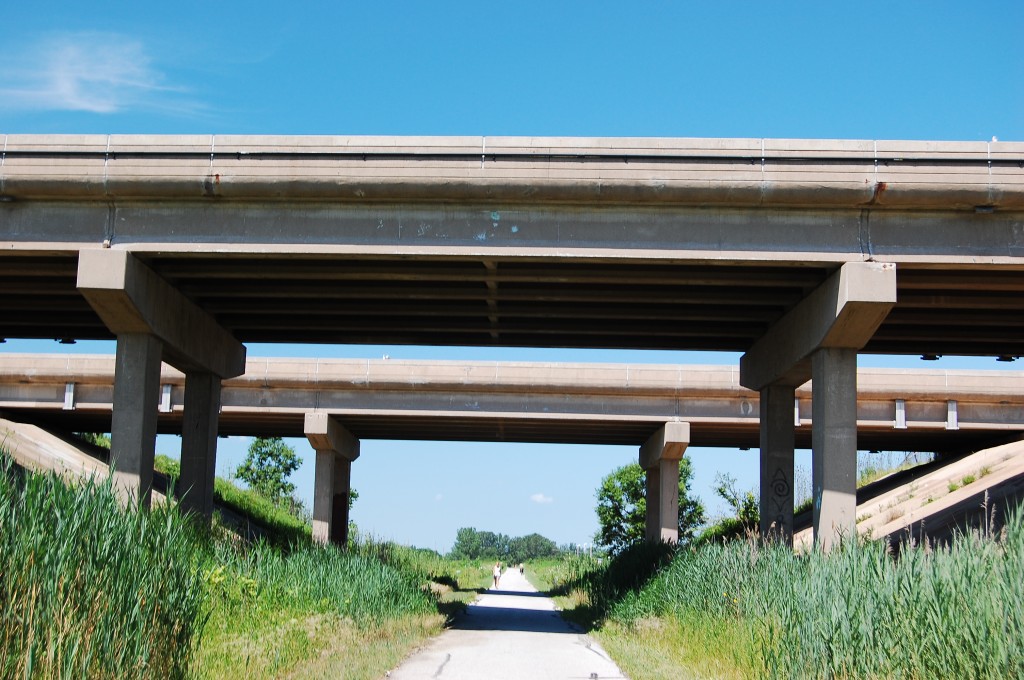Related Resources
The Fix We’re In For: The State of Our BridgesThe State of Our Bridges
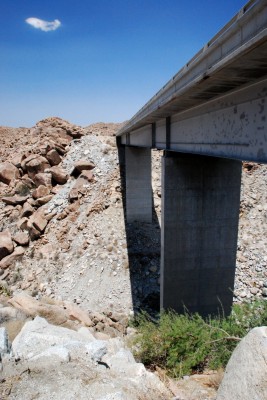 Recommendations
Recommendations
1) As our nation’s bridges continue to age, Congress needs to provide states with increased resources to repair and rebuild them. The federal transportation program currently provides only a fraction of the funds needed for maintenance and repair. Although a number of states are making repair of existing assets a priority, more support from the federal government is essential. The nation’s bridges are aging and traffic demands are increasing, even as state and local revenues are shrinking. Though the size of the federal program increased by 14 percent between 2006 and 2009, state-level needs increased at the same time by 47 percent.
2) Congress also must ensure funds sent to states for bridge repair are used only for that purpose. Today, states can transfer up to 50 percent of their bridge funds to other purposes — even if they have bridges clearly in need of repair. These funds should only be used for other purposes if the state’s bridges are in a state of good repair. In addition, states should be given the flexibility to develop long-term programs that prioritize both keeping bridges in good condition and fixing or replacing deficient bridges. Even in instances where it is more cost-effective to perform regular repair on a bridge to prevent it from becoming deficient, the current federal program only allows states to fix a bridge that is structurally deficient with a low sufficiency rating.
3) Upgrade bridges so that they are safe and accessible for all who use them. Congress should adopt a “complete streets” policy to ensure that when our aging bridges are replaced, they are designed to provide safe access for all who need them, whether in vehicles, on foot or bicycle, or using public transportation.
Overview
Despite billions of dollars in annual federal, state and local funds directed toward the maintenance of existing bridges, 68,842 bridges – representing more than 11 percent of total highway bridges in the U.S. – are classified as “structurally deficient,” according to the Federal Highway Administration (FHWA). Structurally deficient bridges require significant maintenance, rehabilitation or replacement. A number of bridges also exceed their expected lifespan of 50 years. The average age of an American bridge is 42 years.
The maintenance backlog will only worsen as bridges age and costs rise. According to FHWA’s 2009 statistics, $70.9 billion is needed to address the current backlog of deficient bridges. This figure will likely increase as many of our most heavily traveled bridges — including those built more than 40 years ago as part of the Interstate System — near the end of their expected lifespan.
The good news is that some states have worked hard to address the problem and have shrunken the backlog of deficient bridges. The bad news is that, critical as these efforts are, they are not nearly enough. Two key problems persist: First, while Congress has repeatedly declared bridge safety a national priority, existing federal programs offer no real incentives or assurances that aging bridges will actually get fixed. Second, the current level of investment is nowhere near what is needed to keep up with our rapidly growing backlog of aging bridges.
The Tension Between Fixing the Old and Building the New
In recent years, most transportation agencies have delayed needed repairs and maintenance while focusing their energy on new construction. In 2008, all states combined spent more than $18 billion, or 30 percent of the federal transportation funds they received, to build new roads or add capacity to existing roads. In that same year, states spent $8.1 billion of federal funds on repair and rehabilitation of bridges, or about 13 percent of total funds. States currently have the ability to “flex” or transfer out up to 50 percent of their bridge repair money into other projects or programs.
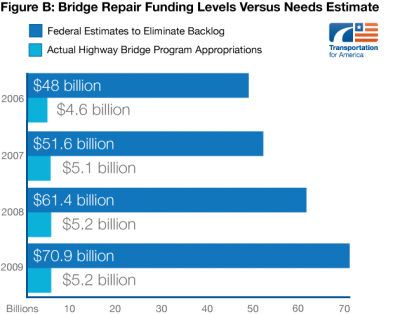
After decades of aggressive highway building, maintenance bills are mounting and coming due. The aging of bridges alone makes a compelling case for Congress to allocate a much larger share of funds toward rebuilding the existing system in the upcoming, six-year transportation funding bill.
For years, the federal government has run a special bridge repair program, but a combination of the program’s shortcomings and the sheer growth in aging bridges has prevented its success. Between 1992 and 2010, the number of vehicles traveling across structurally deficient bridges declined just 2 percent, despite billions of dollars spent annually on bridge construction and repair.
Needs are growing faster than the funding
Congress created the Federal Highway Bridge Program to fix and replace deficient bridges throughout the country, but current funding is insufficient to keep up with rapid deterioration. The graphic above compares the size of the bridge program from 2006 through 2009 with FHWA estimates of the sums needed to catch up on the current repair backlog. While appropriations have increased by $650 million, bridge needs over the same time period have increased by $22.8 billion.
By the end of the last decade, nearly 200,000 of the nation’s roughly 600,000 highway bridges were 50 years old or older. By 2030, that number could double without substantial bridge replacement. At the current rates of aging and replacement, almost half of the nation’s bridges will require major structural investments within the next 15 years.
States Cannot Keep Up Without Federal Support
Bridges provide crucial access between regions and cities, linking workers to jobs, goods to markets and people to essential services. According to the FHWA, transportation agencies would need $70.9 billion to overcome the current backlog of deficient bridges. This investment would be money well spent, as poor bridge conditions have major implications for traveler safety, mobility and economic activity.
Allowing roads and bridges to slip into disrepair ultimately costs state and local governments billions more than the cost of regular, timely repair. Over a 25-year period, deferring maintenance of bridges and highways can cost three times as much as preventative repairs. The backlog also increases safety risks, hinders economic prosperity and significantly burdens taxpayers.
Preservation efforts can also extend the expected service life of a road for an additional 18 years, preventing the need for major reconstruction or replacement. In addition to the safety imperative, investing in the construction, expansion and repair of our nation’s transportation infrastructure creates jobs today while laying the foundation for long-term economic prosperity. Repair work on roads and bridges generates 16 percent more jobs than construction of new bridges and roads.
For all these reasons, Congress has repeatedly declared the condition and safety of our bridges to be of national significance. However, the current federal program does not ensure transportation agencies have enough money and accountability to get the job done.
This must change.




